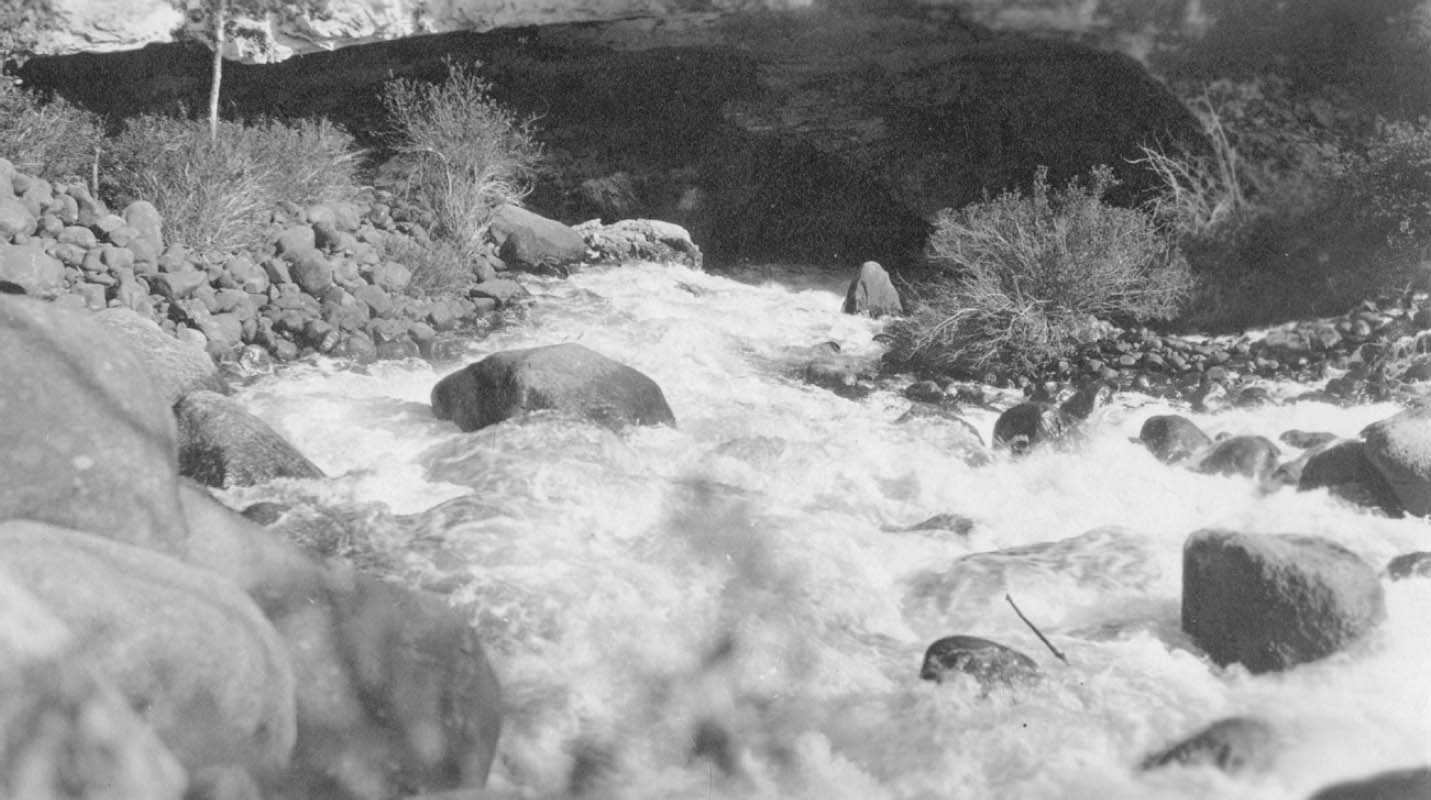
Middle Fork Popo Agie River, Sinks Canyon. J. E. Stimson Collection, State Archives.
CONCLUSION
Takeaways

Middle Fork Popo Agie River, Sinks Canyon. J. E. Stimson Collection, State Archives.
WHERE WATER IS SCARCE, water law can inspire something like religious awe. The Prophet Elwood has long been revered in Wyoming.
But water law is not carved into stone tablets. Rather, the fascination and the value of water law lies in how it is shaped by and reflects the people and the places where it develops and the changes both go through. Water connects people who might prefer not to know about each other. Water law reflects what people do with water and land, and it has long responded, and must keep responding, to changing economies and societies.
The story of Wyoming water offers three lessons.

First, water law is and must be a living thing, serving people in whatever conditions they face.
For people everywhere, that means water law can and must change over time. For Wyoming people, it means understanding that Wyoming water law has changed over time and must continue to do so. Wyoming water law for many decades responded remarkably well to local needs, changing to accommodate a tough landscape and small-time urban and industrial growth. All the while it remained true to the idea that water should be managed for public benefit, an idea expressed in the very structure of Wyoming water management. Nonetheless, over time, water users began to see their water rights as private property. Harsh physical conditions made some state rules unenforceable, and state high court decisions made it almost taboo for a water right to be lost. For a time, the flexibility to accommodate change seemed to disappear. Yet because water in Wyoming is managed by the community of both users and state water supervisors, experimentation with change could and has continued at various levels. Local people have taken steps to meet water needs they see, and interstate challenges have made clearer the role of the state engineer’s office in guarding public benefit from water. Uses, needs, and attitudes to water are shifting, and so is Wyoming’s web of people and rules that govern water use.
Wyoming needs to keep moving on and address unfinished business. The state has to defer to the Shoshone and Arapaho tribes as they use all their water rights in order to create their own best future. The big non-tribal irrigation districts on the Wind River near Riverton must work within water use limits that support fish flows in the river and tribal projects including irrigation and recreation. The state should agree that the tribes can market the water covered by their futures water rights if they so choose.
Wyoming also needs to face climate change with attention to both people and ecosystems. That includes incorporating additional science into water investment planning, policy, and public information. The science should include the best regional projections of the possible future climate and local research into the hydrology past and present. In addition, there need to be more ways for people to support river flows where they live as the climate around them changes. Private groups and individuals should be allowed to own instream flow water rights, and temporary change of use to instream flow should be allowed. Engineer and Board of Control supervision will make that work. Meanwhile, when reviewing all kinds of user proposals for changes in water use, the Board of Control should find its way to considering the impact of new proposals on streams, for flows and for water quality, as well as on water users.
All that can happen within the best traditions of Wyoming water law and with respect for the intense effort Wyoming people have made to use and manage water.

The second lesson from Wyoming’s story is that water law in any location should be guided by one principle: what is at stake, as Mead said, is the public waters.
What we deal with are “public waters” because everywhere in the world, water is a resource easy to waste but difficult to keep people from using. Further, water creates interdependence among people and between people and ecosystems. And the welfare of entire societies depends in part on wise use of water.
An understanding of that should inform both the design of effective water law and the analysis of water-law systems. There are many ways of governing natural resources. Private control through private property is only one option; government control is only one option. There are plenty of other possibilities, including a system that distributes some rights to individuals and some rights to government, as Wyoming’s system has done. In looking at other systems and planning for the future, we should look for the part that the understanding of public waters has played in creating those systems. In those that function well, it will have had a role, as it did in Wyoming.

The third and final lesson from Wyoming water is that anyone who wants to spur changes in water law and management should learn about local water history and aspirations. Water management institutions are a network of rules woven from the experience of a people in a specific place. New challenges create opportunity for reshaping institutions, sometimes moving on from old customs. For people to adopt change, however, they must see the need for it in their place, a link to their traditions, and a path forward.
The combination of climate change and population growth is engaging in water policy new people with new goals. They need to grasp the complicated story of what has gone before and why. Then they can meet the future by combining the best in local knowledge with the latest in science and policy.